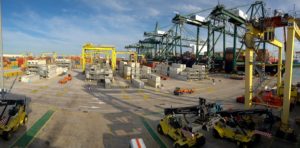
H2Ports, coordinated by the Valenciaport Foundation, incorporates hydrogen into port logistics operations with the aim of reducing their environmental impact
The application of hydrogen in the transport and logistics sector is one of the fundamental axes of the “Hydrogen Road Map: a commitment to renewable hydrogen”. This initiative, recently approved by the government at the proposal of the Ministry for Ecological Transition and the Demographic Challenge (MITECO), aims to deploy this sustainable energy, which is key for Spain to achieve the goal of climate neutrality.
The H2Ports project, coordinated by the Valenciaport Foundation in collaboration with the PAV, is one of the model initiatives highlighted by MITECO in this Hydrogen Roadmap. H2Ports is a pilot project for the area of mobility and maritime transport that is being carried out in the Port of Valencia to incorporate hydrogen into port logistics operations with the aim of reducing its environmental impact, and which will make Valenciaport the first port in Europe to incorporate hydrogen energy into its terminals. H2Ports is one of the five ongoing initiatives highlighted by MITECO in the field of hydrogen whose relevance has been recognised through the granting of public funding from state or European funds.
The project allows testing three pilots that will operate in the Port of Valencia: a hydrogen-powered reach stacker for loading/unloading and transporting containers; a terminal tractor head for ro-ro operations, powered by hydrogen cells; and a mobile hydrogen supply station that will provide the necessary fuel to guarantee the continuous work cycles of the above-mentioned equipment. The project also has as a cross-cutting objective to carry out feasibility studies for the development of a sustainable hydrogen supply chain in the port, coordinating all the actors involved: customers, hydrogen producers, suppliers, etc. H2Ports is the result of a public-private collaboration and has the participation of the PAV, the Valenciaport Foundation, the National Hydrogen Centre and the companies MSC Terminal Valencia, Grimaldi Group, Hyster-Yale, Athens, Ballard Power Systems Europe and ENAGAS.
The National Hydrogen Centre (CNH2) is currently developing the hydrogen supply station (which will guarantee the supply of this fuel, under appropriate conditions, during the simultaneous operation of the other two pilots to be tested throughout the project: a Reach Stacker, for MSC Terminal Valencia, and a 4×4 terminal tractor, at Valencia Terminal Europa of the Grimaldi Group, both powered by fuel cells.
The initiative, which has a total investment of 4 million euros and is financed by the Fuel Cell and Hydrogen Joint Undertaking (FCH JU) programme, will test and validate hydrogen technologies on port machinery with the aim of having applicable and real solutions without affecting the performance and safety of port operations and producing zero local emissions. H2Ports has been internationally recognised with the GREEN4SEA Port Award 2019 in environmental matters.
Valenciaport, Roadmap partner
Valenciaport was one of the entities that actively participated in the consultation carried out by the Ministry for the development of this national strategy to promote this green energy. The “Hydrogen Road Map” establishes a series of objectives to make this renewable energy a key sustainable solution for the decarbonisation of the economy and to achieve climate neutrality by 2050, an objective that in the case of the Valencia Port Authority (PAV) is anticipated twenty years ahead with its plan “2030, zero emissions”.
The Council of Ministers approved this Hydrogen Roadmap on 6 October, which forms part of the Integrated Energy and Climate Plan (PNIEC) 2021-2030, which includes 60 measures and sets national targets – in line with the European Hydrogen Strategy – for 2030. This document favours “the development of renewable hydrogen that will encourage the creation of innovative industrial value chains, technological knowledge and the generation of sustainable employment, contributing to the reactivation towards a green economy with high added value”.

